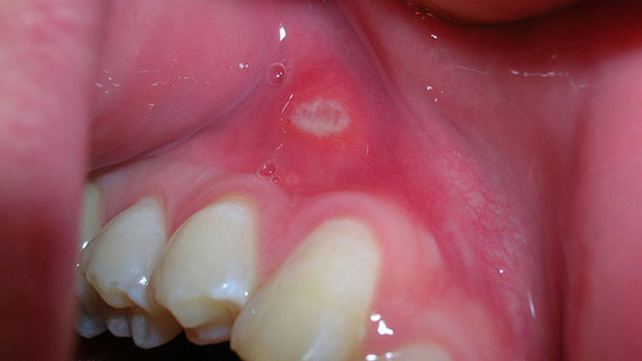
Oral cancer, also known as oral cavity carcinoma, is a malignant tumor in the oral cavity that is usually caused by excessive tobacco or alcohol consumption. The tumor can be recognized by white or reddish spots, for example on the tongue or gums. Oral cancer always requires medical treatment. The earlier it is diagnosed, the better the prognosis. Find out more about symptoms, treatment, and diagnostics here.
quick overview
- What is oral cancer? A malignant tumor that affects the mucous membrane of the inner cheeks, floor of the mouth, palate and tongue, as well as the jaw , salivary glands and lips, among other things
- Causes : Pathological transformation or new formation of cells in the skin or mucous membrane, triggered by carcinogenic substances (carcinogens)
- Risk factors: nicotine (tobacco) and alcohol, human papilloma virus ( HPV ), possibly genetic factors, consumption of betel nuts
- Signs (Symptoms): White or reddish spots, pain, difficulty chewing and swallowing, swelling, bleeding, numbness , bad breath , loss of appetite , weight loss, poor performance
- Treatment: Depending on the tumor stage: surgical removal (resection) if possible with reconstruction, radiotherapy and/or chemotherapy
- Course and prognosis: Depending on the time of diagnosis and treatment, a cure is possible. The earlier treatment is given, the better the prognosis for oral cancer. Relapses may occur within five years of treatment.
- Diagnostics: Tissue examination (e.g. reflection with biopsy ), ultrasound , X- ray , positron emission tomography ( PET ), computed tomography (CT), magnetic resonance imaging (MRT)
- Prevention: renunciation of the consumption of tobacco of any kind, drinking little or no alcohol, careful oral and dental care, attending dental check-ups
Oral cancer or oral cavity cancer is technically called oral cavity carcinoma. It is a malignant tumor (malignant carcinoma) in the mouth. The term oral cavity carcinoma is a collective term that includes all malignant cancer variants that occur in connection with structures of the oral cavity.
frequency
Oral cavity cancer is one of the most frequently diagnosed types of cancer worldwide. An average of around 10,000 new cases per year occur in Germany. Men between the ages of 55 and 65 are affected more often than women, who are most commonly diagnosed with oral cancer between the ages of 50 and 75. In western Europe, the number of new cases per 100,000 population is 6.9 for men and 3.2 for women.
causes
Oral cancer is a malignant tumor that is based on a spontaneous degeneration of cells in the oral mucosa, which then multiply uncontrollably. Doctors refer to this process as carcinogenesis. The cause is the influence of carcinogenic substances. In the case of oral cavity cancer, it is primarily the nitrosamines contained in tobacco, for example, that penetrate the skin cells and change the cell’s genetic material.
risk factors
The main risk factors associated with the development of oral cavity cancer are tobacco and alcohol. Excessive or chronic consumption of tobacco or alcohol increases the risk of developing oral cavity cancer by a factor of six. Those who consume tobacco and alcohol at the same time increase their risk of oral cancer by a factor of 30.
Another risk factor for oral cancer is an unbalanced and very meaty diet. In particular, heavily fried foods pose an increased risk because of the nitrosamines they contain. In Asia, the excessive consumption of the betel nut, which – like caffeine – contains psychoactive substances, plays a role. However, in western countries, it has no significant relevance for the development of oral cavity cancer.
Some studies indicate that human papillomavirus (HPV) poses a risk for oral cancer. However, the estimated proportion of people currently suffering from oral cancer, in which the disease can be traced back to an HPV infection, is less than five percent.
It is also assumed that a genetic predisposition (predisposition) also promotes the development of oral cancer.
Where does it occur?
In more than 90 percent of cases r, the oral mucosa is pathologically altered, which is why this type of tumor is usually a so-called squamous cell carcinoma (SCC). But sometimes malignant cells also form in other parts, such as the muscles, glands or lymphatic tissue. Oral cancer occurs in the following areas of the oral cavity:
- Floor of the mouth (floor of the mouth cancer, medical: floor of the mouth carcinoma)
- Tongue ( tongue cancer , medical: tongue carcinoma)
- Inner cheek wall (colloquially: cheek cancer)
- Hard and soft palate (cancer of the palate, medical: carcinoma of the palate)
- Jaws (e.g. jaw bone cancer, medical: jaw bone carcinoma)
- Gums (gum cancer, medical: gingival carcinoma)
- Lips (lip cancer, medical: lip carcinoma)
- Almonds (tonsil cancer, medical: tonsil carcinoma)
- Salivary glands
Is it Curable or Fatal?
In principle, there is the possibility of surgically removing a tumor in the oral cavity or treating it with the help of radiotherapy and/or chemotherapy. Which treatment method is ultimately the most suitable depends on various factors. The age and the general state of health of the person concerned play a decisive role.
However, the severity of the disease is more important. Comprehensive diagnostics are therefore carried out before each intervention. The results provide information about the stage of the tumor and what treatment successes and risks can be expected in each case. An interdisciplinary team of treating physicians puts together the final treatment plan together with the patient.
Preventative dentistry is a major focus of Dr. Pascal Terjanian’s practice. He considers the role of nutrition and overall physical health when assessing dental issues and appropriate treatments. Good oral hygiene and regular dental check-ups form the foundations of preventative dentistry. Dr. Pascal Terjanian maintains a blog on dental issues, covering preventative dentistry topics as well as providing information on warning signs that might warrant professional attention. The blog plays an important role in his strategy for providing quality preventative care.

